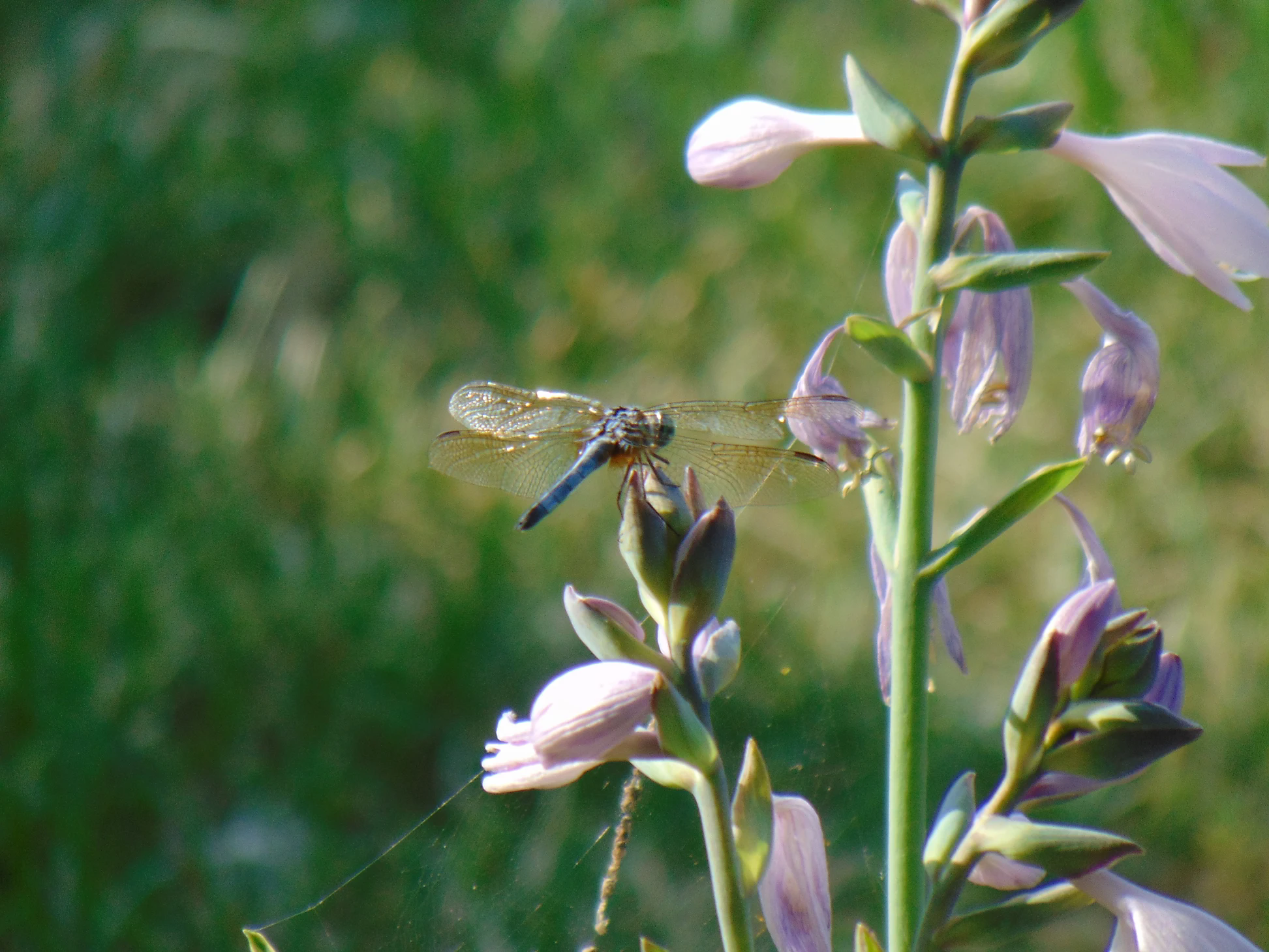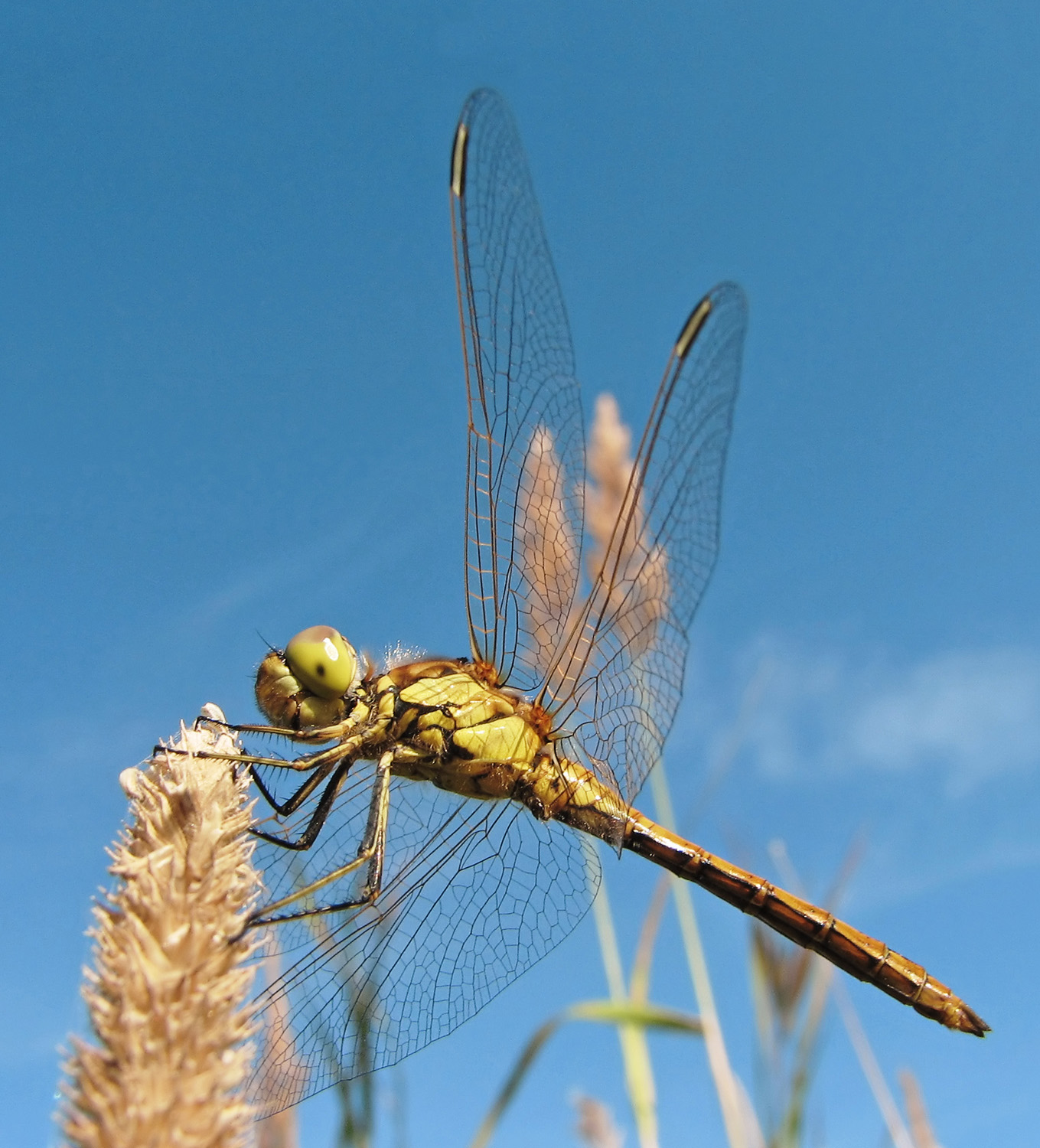Species: Blue Dasher – Pachydiplax longipennis
B.C. Status: Blue
COSEWIC Status: Special Concern
Key Information:These vibrant dragonflies are one of a kind – the only member of its genus and the largest member of the skimmer family. Found living in and around still water, they are natural residents to wetlands and can be spotted flying around lakes, marshes, and bogs.
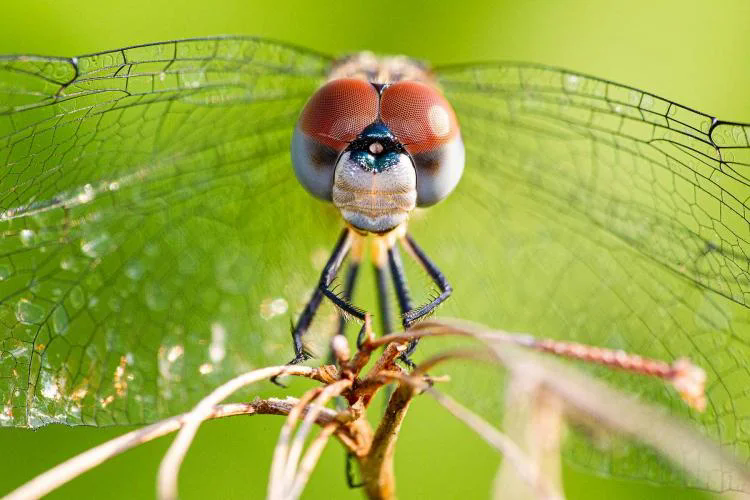
A dragonfly’s life is a process of metamorphosis. Females lay their eggs on plant matter on the surface of the water; and within 35 seconds they can lay up to 700 eggs! Once hatched, they begin life underwater as a nymph feeding on insects, invertebrates, small fish, and tadpoles. Themselves, they are also prey to fish.
At this stage, they are highly tolerant of wetlands with poor water quality and low dissolved oxygen levels. This makes them perfect predators of mosquito larvae, which also live in still or stagnant water.
Once matured and when the weather is right, they complete metamorphosis by emerging from their exoskeleton. Out of the water and up to the skies they go! They live the remainder of their life as winged-adults – ready to mate, reproduce, and eat flying insects.
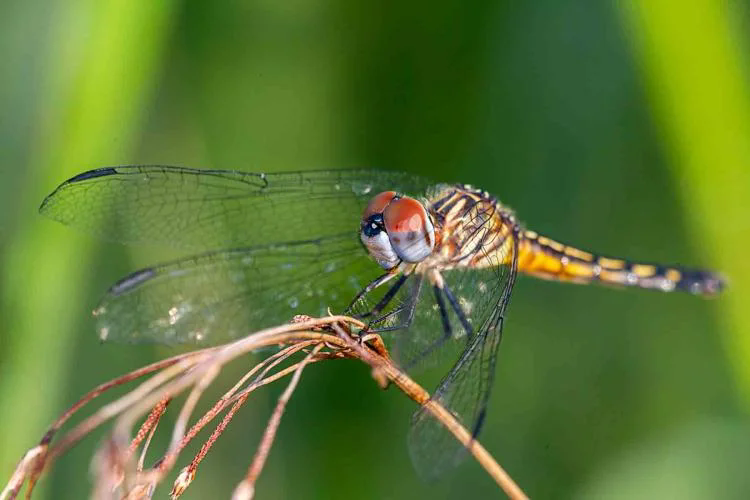
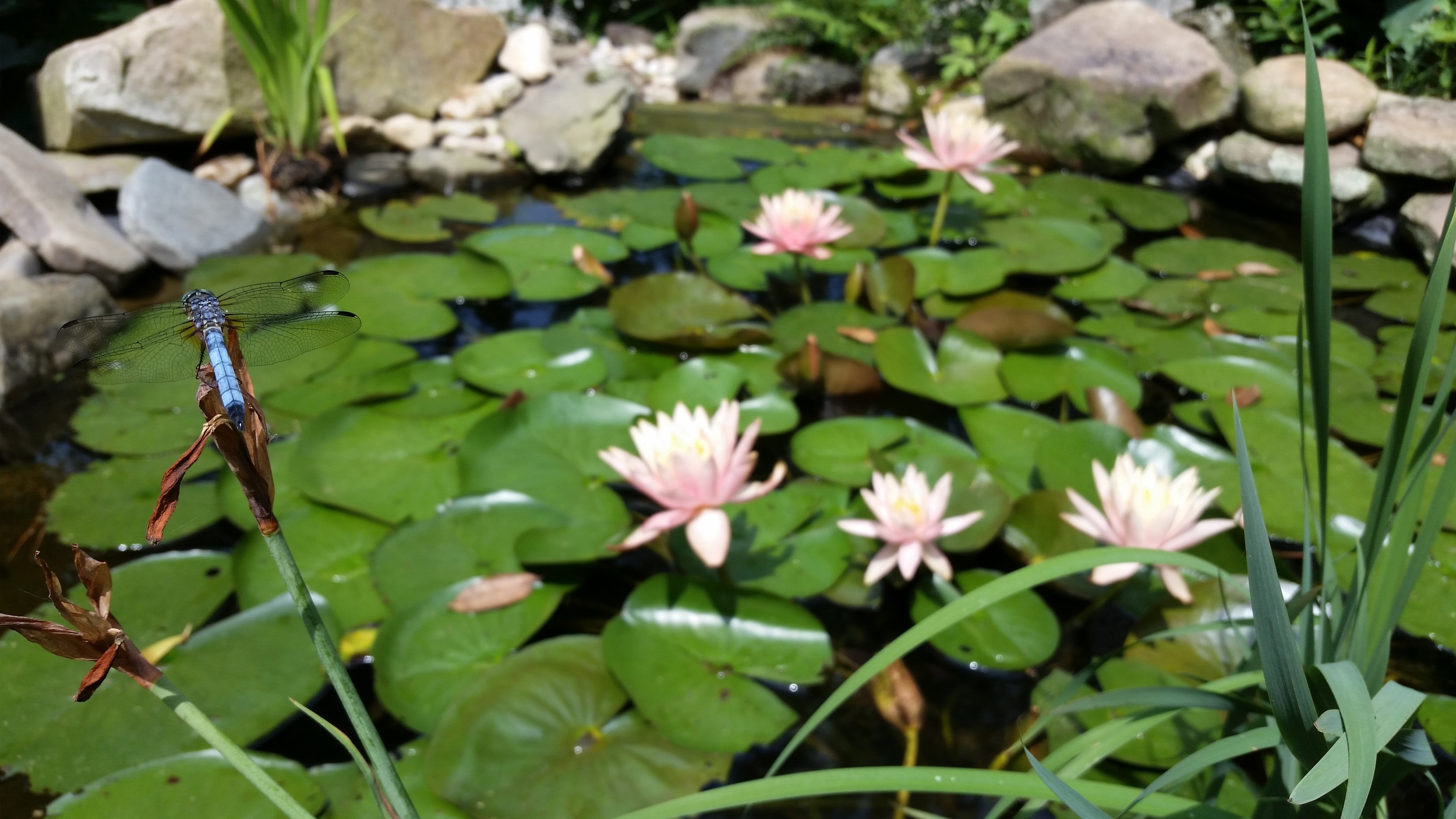
Blue dashers are very aggressive predators and will eat hundreds of flying insects a day – which is up to ten percent of their body weight! They will defend their food sites for several days and then move on to another area of the water body. Males are often seen near water edges, creating their territory, whereas the females are seen around the vegetation. The only time the female blue dasher will approach the water is to lay her eggs; which happens in a matter of seconds.
The mating and courtship process between dragonflies is quite unique – you can watch in the video below in the Useful Links. They mate in the air, and when perched, they both close their wings and raise their abdomen. If you see this process, you may be a witness of the magic of life – which can be as quick as 2 minutes! Males will continue to be on guard throughout the fertilization and egg-laying process to prevent other males from attacking her and her eggs.
Although they are tolerant of poor water quality, they are under threat from both habitat loss and pollution. The destruction of wetlands for development, water diversion, and pollution/pesticide input into water bodies are threatening blue dasher populations; and many other species.
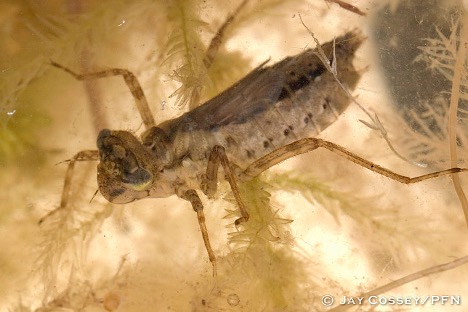
Males:
- Blue body with a white face
- Blueish/amber eyes
- Black tip to the abdomen
- Black and yellow striped thorax (head)
- 28mm to 45mm in length
- Develop sky blue abdomen when they reach maturity
Females:
- Dark bodies with yellow stripes downside
- Amber/blueish eyes, more amber than the males
- Once mature, they will turn blue but less vibrant than the males
Scientific Name:Pachydiplax longipennis
FamilyLibellulidae (skimmers) in the order Odonata (dragonflies and damselflies)
Description:Blue dasher males and females look quite different. Both have a white face, a black abdomen tip, and slanted black and yellow stripes on the thorax. There is an amber cast on the hindwing bases. But males are blue and females are striped black and yellow.
Mature blue dasher males are chalky blue with a dark abdomen tip, white face, and turquoise eyes. There’s a wedge of rust or yellowish color on each side of the front part of the abdomen, behind the wings. Younger males look like females. Males intermediate in age display a mix of mature male and female characteristics.
Female blue dashers have a pair of yellow stripes on each side of the top of the abdomen; a white face; and (usually) eyes that are divided into two sections: rusty brown above and sky blue or gray below. There is a small tuft of white or pale yellow at the tip of the abdomen.
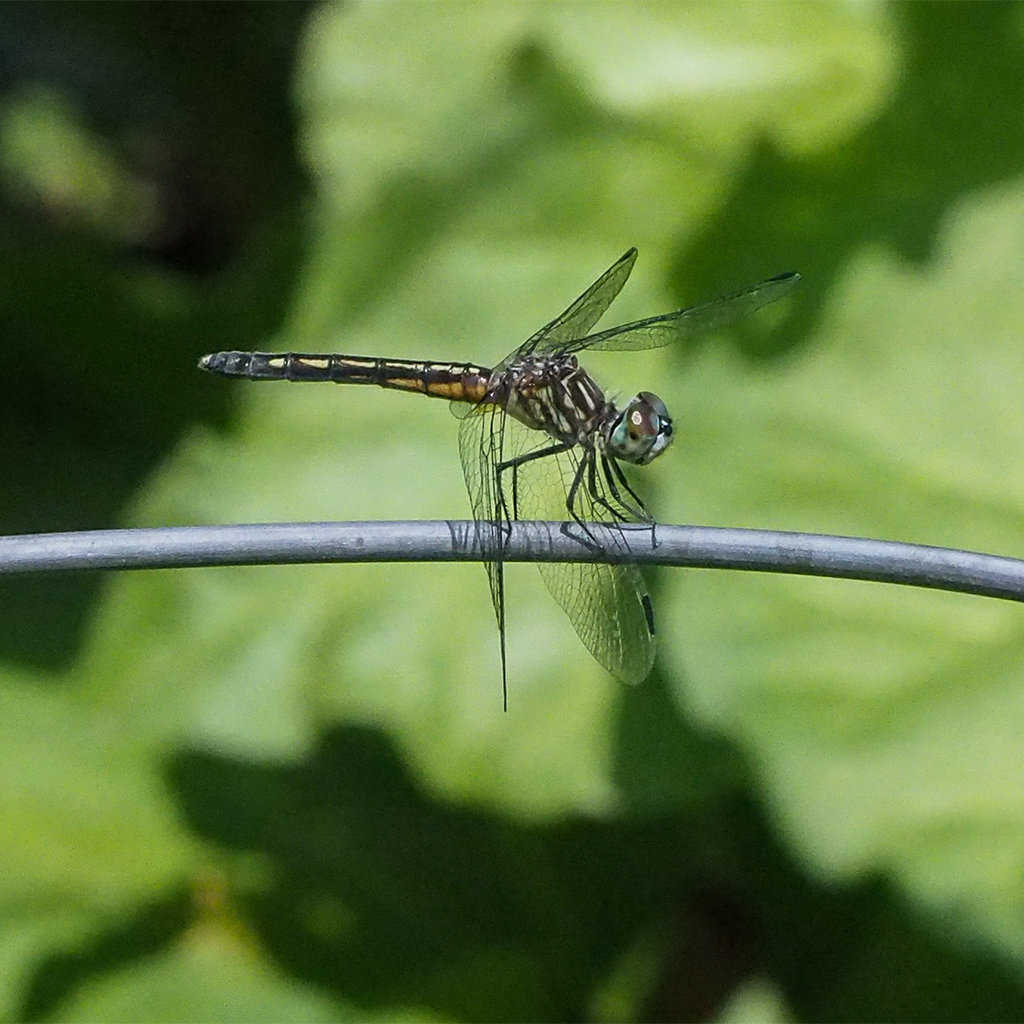
Habitat
Blue dashers live near still, calm bodies of water, such as ponds, marshes, slow-moving waterways, and ditches, in warm areas typically at low elevations. The adults roost in trees at night.
Diet and feeding
These dragonflies, like others of their infraorder, are carnivorous, and are capable of eating hundreds of insects every day, including mosquito and mayfly larvae. The adult dragonfly will eat nearly any flying insect, such as a moth or fly. Nymphs have a diet that includes other aquatic larvae, small fish, and tadpoles.These dragonflies are known to be voracious predators, consuming up to 10% of their body weight each day in food.
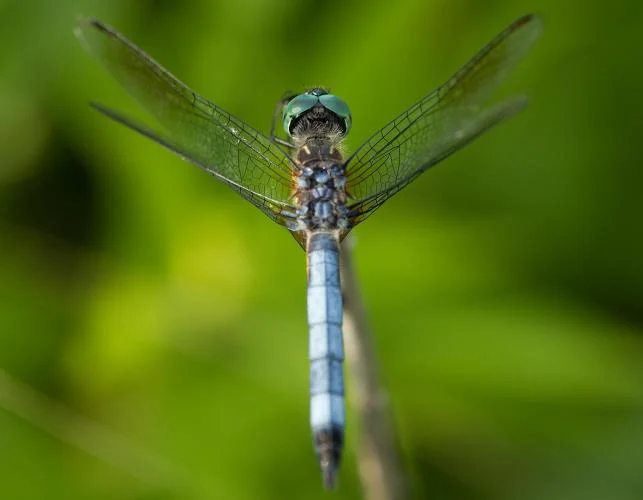
The blue dasher hunts by keeping still and waiting for suitable prey to come within range. When it does, they dart from their position to catch it.
The foraging behavior of this dragonfly is influenced by different factors, such as external temperature, prey availability, and perch position. P. longipennis tends to forage on small prey, which differs from the unselective foraging behavior of other Odonata species. This species also moves to different foraging sites frequently, meaning they do not stay put in one place too long searching for food. P. longipennis also exhibits aggressive behavior when foraging for food. Both males and females take part in this aggression when looking for prey. P. longipennis will engage in this behavior towards individuals of the same species and individuals of other species, but males tend to fight (and win) more often than females. Researchers suggest that the more successful an individual is using aggression, then the more likely they will gain a better perch and thus increase their chance to find prey.
Life history
Pachydiplax longipennis larvae exhibit asynchronous emergence, meaning that the larvae do not emerge at the same time as one another. Based on general time of emergence, this species is still classified as a summer species. The larvae of this species often vary greatly in regard to size due to generational overlap of groups. This generational overlap is created by some groups producing one brood and other groups producing two broods in a breeding season.[ The timing of P. longipennis larvae emergence has also been linked to the presence of its predator, Anax junius. Research has shown that if larvae are in their peak physical state, then they have a higher likelihood of emerging in the presence of their predator, as opposed to weaker larvae likely emerging in the absence of the predator. Cannibalism also poses a threat, and the stronger larvae emerge earlier when this threat is high.
Identifying the Blue Dasher Dragonfly
Identifying the Blue Dasher
The males and the females look quite different. It is the males who have the black-tipped blue abdomens, white faces and metallic green eyes. Females and immature males have brown thoraxes with yellow stripes and reddish-brown eyes.
This is a Blue Dasher (Pachydiplax longipennis) dragonfly. Apparently, “longipennis” means “long-winged”. Thank goodness. The Blue Dasher is also called the Blue Pirate. This species is abundant across much of North America. It is classified as a member of the Skipper family.
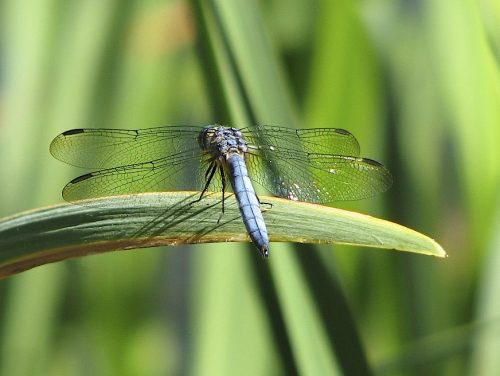
A Dragonfly’s Wings
The intricate delicate wings are engineering marvels. Not only can they beat up and down, but all four wings can move independently. The wings can also rotate like an airplane propeller. Dragonflies can fly up, down, backwards, forwards and hover in mid air.Sometimes the markings on the wings are useful in identifying species.
What do Blue Dashers do?
The males have a favorite perch which serves as their headquarters. From this perch, the males periodically fly over the pond and chase other males. The males spend much of their time chasing each other and displaying their blue abdomens.
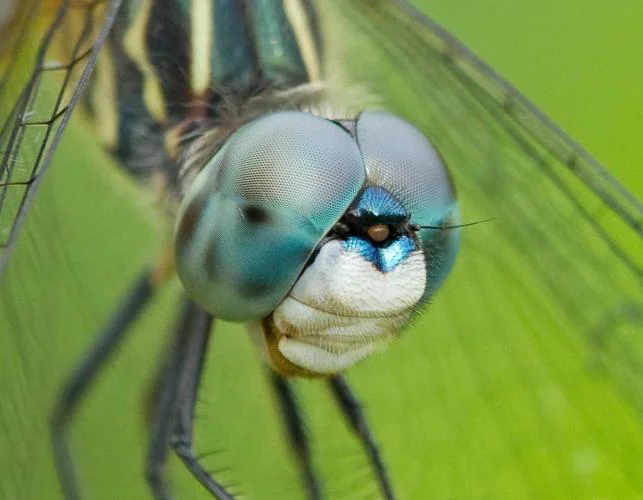
This male (known by the blue color of the abdomen) is perching on a plant stalk overlooking a pond. Blue Dashers display behavior called perching. Perchers, in the dragonfly world, perch horizontally on shoreline shrubs and vegetation, many times high up from the ground. Perchers make brief flights at low (under six feet) heights over their territory. Which is exactly what this dragonfly did. Other dragonflies are “fliers” which spend long periods flying, not perching.
How long do they live?
Adult dragonflies can live several years. In the larval stage they can live in the water up to two years after hatching. The female dragonfly lays her eggs underwater.
What do they eat?
Dragonflies are voracious eaters who are know to eat up to 10% of the body weight each day. Both the aquatic larvae and winged adults are predators who eat other flying insects. Most of their prey is smaller than they are such as tiny flies, leafhoppers, beetles, ants, moths, butterflies, etc. The large dragonflies, such as the Blue Dasher, may eat other dragonflies or damselflies.
Where do Blue Dashers live?
I spotted many Blue Dashers around a body of standing water (a pond in this case) with some vegetation. If water doesn’t have some vegetation, Blue Dashers are unlikely to be there.
Fun Facts about Dragonfly Nymphs
This is a dragonfly nymph. Dragonflies have a three-part life cycle of egg, larva (nymph) and adult. They go through metamorphosis much like other insects. When a dragonfly nymph is fully growth it climbs up a stalk, out of the water and the adult form emerges.
Dragonflies breathe through gills in their rectum. The rear end of a dragonfly functions as an extraction machine which separates oxygen from the water so the dragonfly can breathe. I think the expelling of the water is what also gives the rectum functions as jet propulsion underwater. The dragonfly must shoot water out of the rectum which creates the jet propulsion underwater. The rectum is also the end of the digestive track and performs the usually waste disposal actions. In the book Dragonflies and Damselflies of the East, Dennis Paulson calls the nymph rectum a “multipurpose organ” and a “miraculous rectum”.
They migrate… we think
The Blue Dasher is one of the species of dragonflies that appears to migrate. I say appears to migrate because large populations of Blue Dashers are seen in midsummer along the Atlantic Coast. No one knows where they go.
Conclusion
I spent an hour watching dragonfly behavior at the pond. It was hot but I was fascinated. Since Blue Dasher are among the most common and abundant dragonflies in North America, you are bound to see one.
August is the time I see the most dragonflies. I have notice many dragonflies zooming through the air in mid-August through September. THey are going somewhere, we just don’t know where.
Blue Dasher
What to look for? Smaller, beautiful dragonfly with distinctive coloring! The upper or dorsal portion of the abdomen and the thorax is a pale pruinose or powdery blue color. The face is white. The eyes are jade-green in males and reddish-brown in females. The front of the thorax is brown with pale green sides and yellow stripes. The wings are typically clear but may be somewhat flavescent or yellowish. Both genders have an amber patch at the base of each hindwing. The legs are black. Dragonflies have segmented abdomen (typically ten segments). The second to last segment is black or dark on the Blue Dasher with the last segment pale.
Where can they be found at Carillon Stonegate Pond? The Blue Dasher will be found here from June to September. Look for them flying around the water’s edge. They will often perch on tips of our tall grasses and water plants surrounding our ponds. They may even settle in on your lawn chairs!
How big are they? Small dragonfly. The Blue Dasher averages approximately one and one-half inches in length. And their wingspan is approximately one and one-half inches.
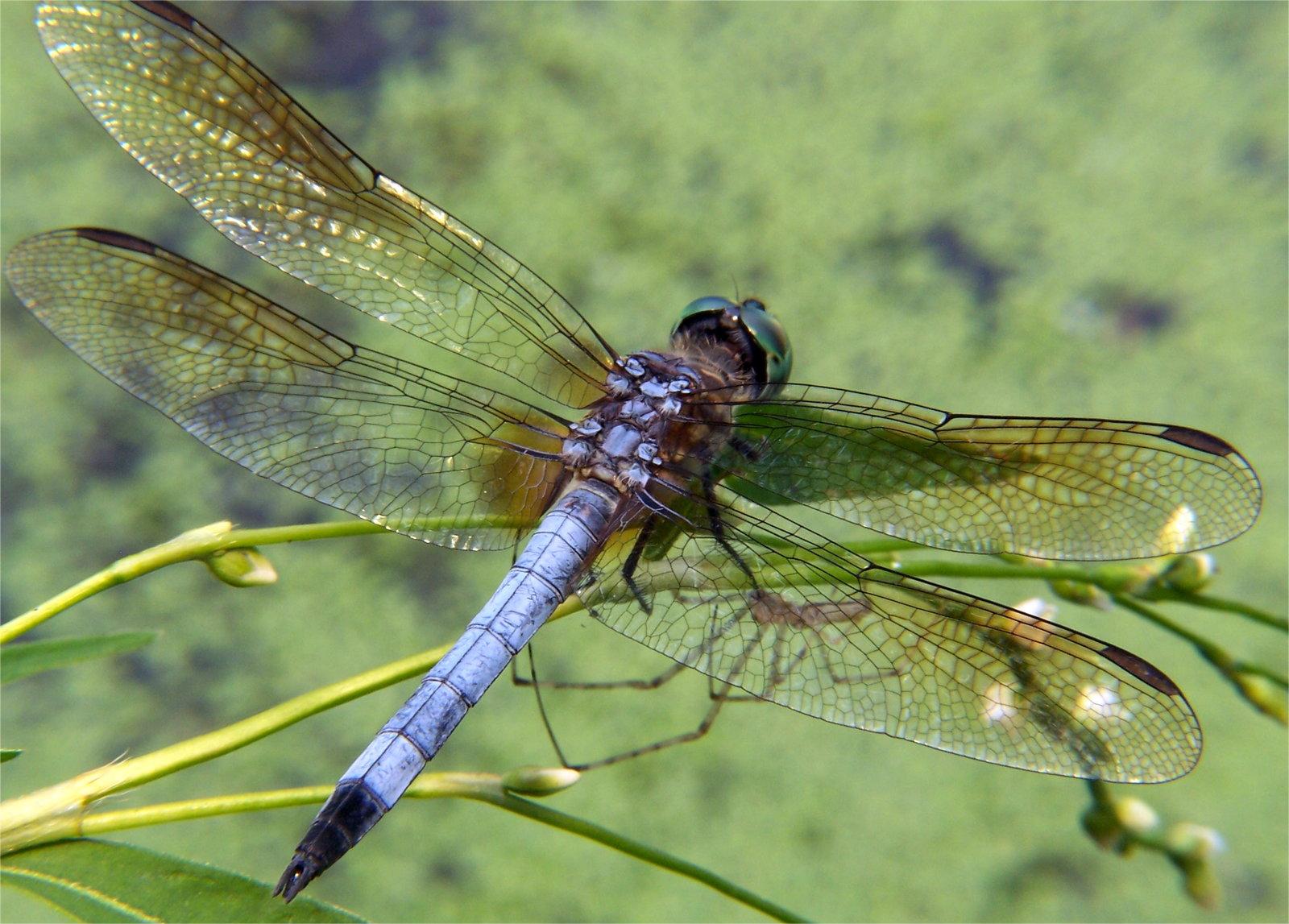
What are their flight patterns? The Blue Dasher is an active flier. Males may be seen regularly battling over territories and chasing each other around the bulrushes and cattails on Carillon Stonegate Pond. From their perches located at the tip of tall grasses and wildflowers, they fly out to capture prey.
How else do they behave? Blue Dashers are aggressive predators, regularly taking over 10% of their body weight in prey daily. The Blue Dasher is often seen perched vertically on twigs and branches in trees at a variety of heights. Both genders stick their abdomens upright in the air when perched, as if on alert.
What’s for dinner? Flying insects! Adult Blue Dashers will eat almost any small, soft-bodied flying insect, including mosquitoes, flies, butterflies, moths, mayflies, and flying ants or termites. Larval dragonflies are called naiads. During their larval stage, naiads feed on a wide variety of smaller aquatic insects, such as mosquito larvae, other aquatic fly larvae, mayfly larvae, and freshwater shrimp.
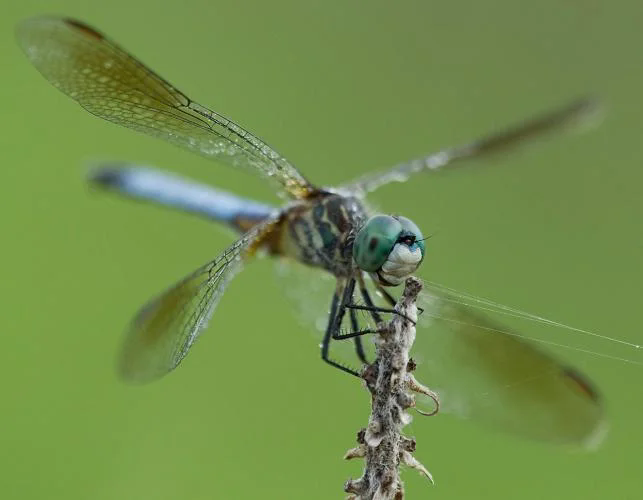
Where do they take up residence? The preferred habitats of the Blue Dasher are still water bodies such as ponds, marshes and lakes throughout much of the U.S., except the Great Basin and Rocky Mountains, and into southern Canada.
When and where do they breed and nest? Male Blue Dashers will establish multiple breeding territories along the shoreline. They will defend and chase other males out by raising their pruinose blue abdomen upright. Mating takes place while in flight or perched. The male will guard the female from a nearby perch while she deposits eggs. She may lay 500 or more eggs by flying low over the water usually near a heavily vegetated pond edge and repeatedly tapping her abdomen to the surface. Females remain farther back from the water when not laying eggs or mating. Once the Blue Dasher eggs hatch, the life cycle of a dragonfly larva begins as a nymph. A nymph looks like a little alien creature or a squat bug. They live underwater and eat smaller aquatic insects including other naiads sharing the same pond. This phase of their life cycle can take up to several years to complete. They eventually emerge from the water as adults at night.
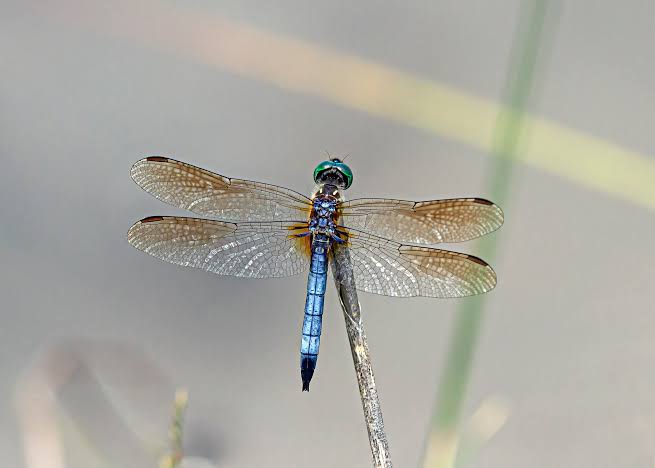
Some dragonfly facts:
Dragonflies catch up to 95 percent of the prey they pursue, making them one of the most efficient hunters in the animal kingdom.
The dragonfly has two sets of wings that work independently. This allows them to change direction in midair by changing the angle of each wing. They can fly in any direction or hover in one spot for more than a minute.
Fossil records show that dragonflies were alive more than 100 million years before dinosaurs roamed the earth.
Dragonflies are the world’s fastest insects. They can fly at speeds up to 38 miles per hour.
Dragonflies, with their appetite for mosquitoes, are indicators of a healthy ecosystem. Unfortunately, dragonfly populations around the world are in dangerous decline owing to decreasing wetlands, global warming and the use of pesticides.

